For those of you reading our posts regularly, you’re probably wondering what the heck happened to our Greece trip. It was almost a month ago, right? Yeah, and what a month. We’re back in Pennsylvania where we’ve been celebrating the opening of the newest addition to the family: The Tavern on the Square (Google it), spending time with our grandkids, and just generally really busy! Who knew retirement would be so full?
When our good friends, John and Debby, invited us to join them for a Greek Adventure, we didn’t hesitate. Last year, it was John and Debby who gave us our first taste of Italy, and since we were in the middle of planning a big return trip to Italy, we were happy to let them make all the arrangements for Greece, allowing us to just show up for the adventure. I’m going to tell you right up front that touring the sites of ancient Greece proved to be more profound than anticipated.
Another Foodie Heaven
We arrived in Athens a couple of days before our friends and were eager to get to know the city. It will come as no surprise, if you have been following our adventures, that we began our exploration of the city with a walking food tour. Once again, a Culinary Backstreets tour provided six wonderful hours of eating, drinking, walking, and generally becoming oriented to Athens as a modern city. I’ll share just a few of the most interesting and delicious highlights.
Not a Bagel
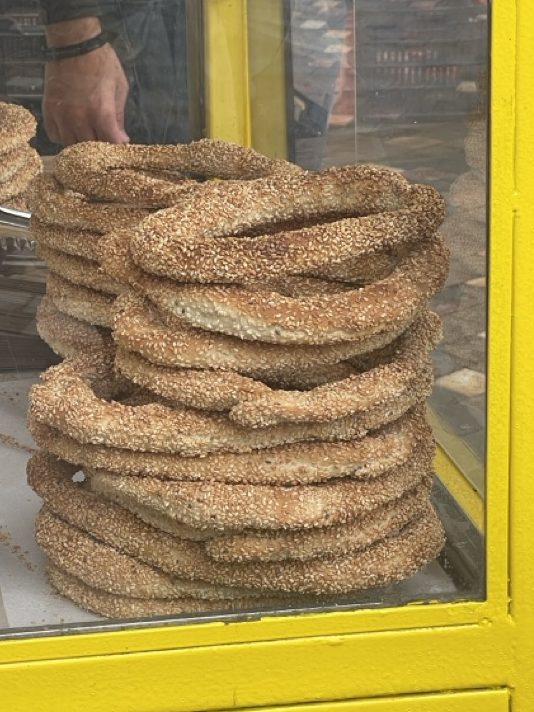
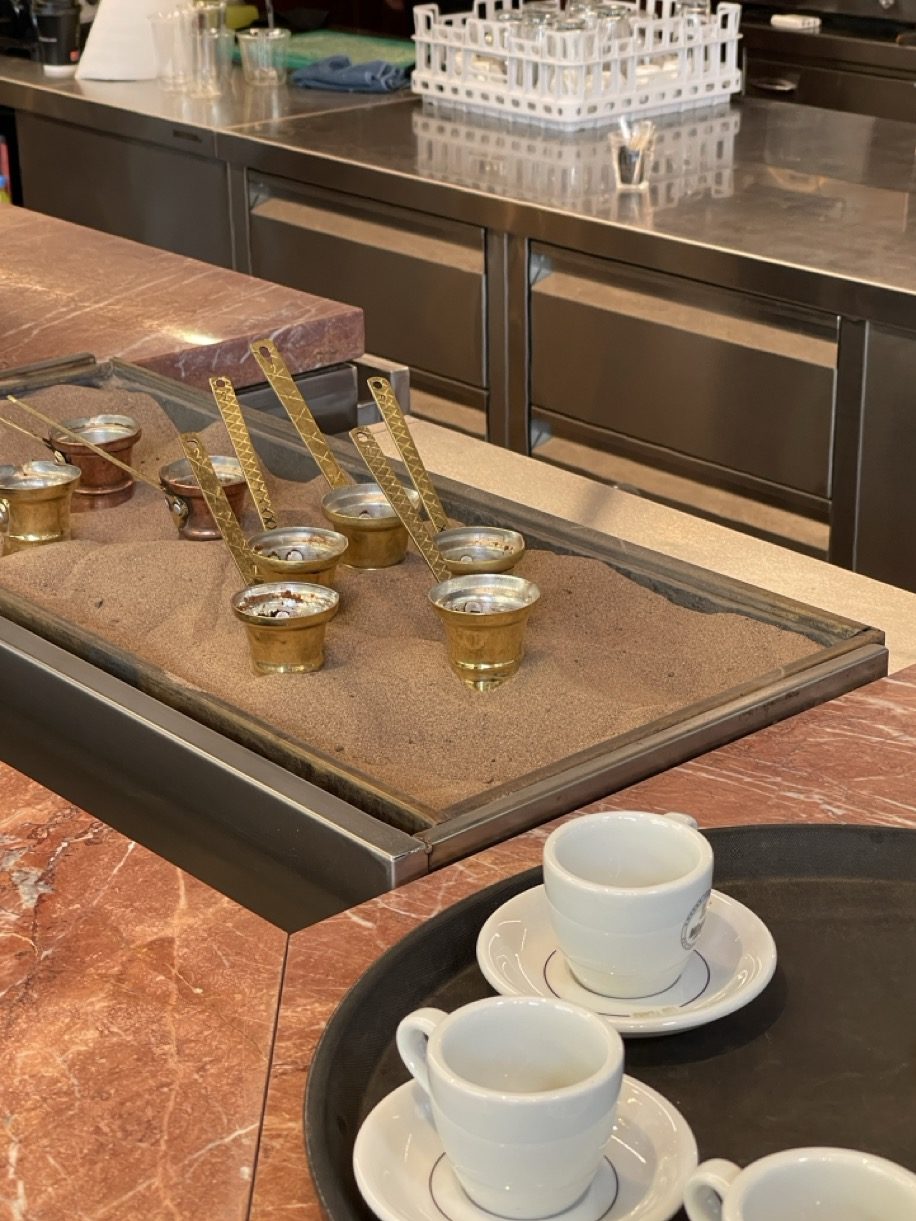
Our first stop was a street vendor selling Koulouri Thessalonikis from a small, bright yellow cart in one of central Athens most picturesque squares. These bread rings, which are crunchy on the outside, covered with sesame seeds with a slightly chewy center, are one of the most popular breakfasts for Greeks, along with a hot cup of Greek coffee (ellinikos Kafes) or a Frappe.
Greek coffee starts with beans that are roasted and ground into a fine powder (think cocoa powder) put into a briki (small brass pot) with water, and placed on a hovoli to boil (yep, it’s boiled, not brewed). A hovoli is a special piece of equipment that heats sand. The coffee is constantly whisked and teased to boiling point as the sand around the vessel creates a hot bath for it. Once the water boils and rises to the top of the briki, it is removed from the sand and given a rest to allow the coffee to settle. The smell is amazing as you carefully pour the black liquid from the brass pot into a small cup being careful to avoid including any of the sludge. I don’t typically drink coffee, but I found this version to be delicious – no bitterness. And, following the guide’s recommendation I even had mine without sugar. Because it is boiled rather than brewed, more nutrients, antioxidants, and health-boosting compounds are extracted from the coffee bean.
Sweet Treats
Along with our Greek coffee, we enjoyed Loukoumi – delicious, soft, little squares of sweetness coated in powdered sugar. We remembered fondly tasting this sweet treat on our trip to Istanbul several years ago where it’s called Lokum (aka Turkish Delight). My favorite is rose flavored Loukoumi which is like eating a rose petal.
Phyllo Perfection
At our next stop, we stood outside a “pie shop” and watched a master at work. Making phyllo dough takes patience because the gluten in the dough needs plenty of time to relax before you can stretch it as thin as paper. The result was layers of buttery, flakey phyllo filled with spinach and feta cheese – the best spanakopita we have ever tasted. But wait, there’s more. Bougatsa is a creamy custard filled phyllo pastry dusted with powdered sugar and cinnamon that is eaten all over Greece. Phyllo heaven.
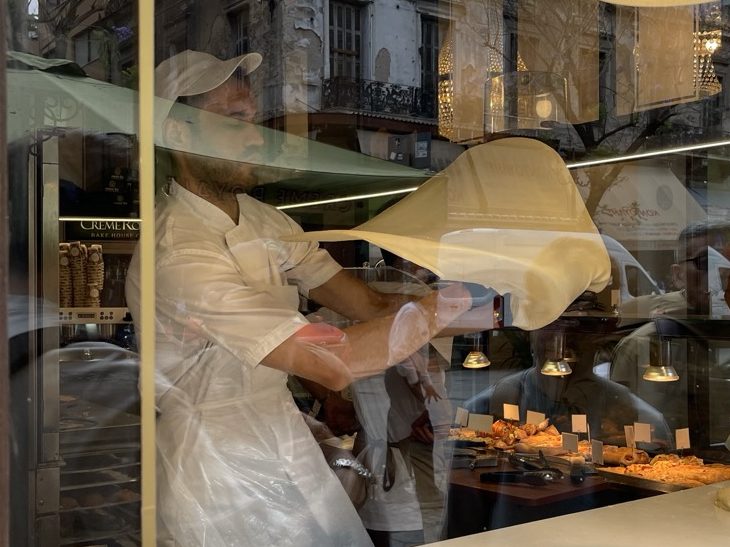
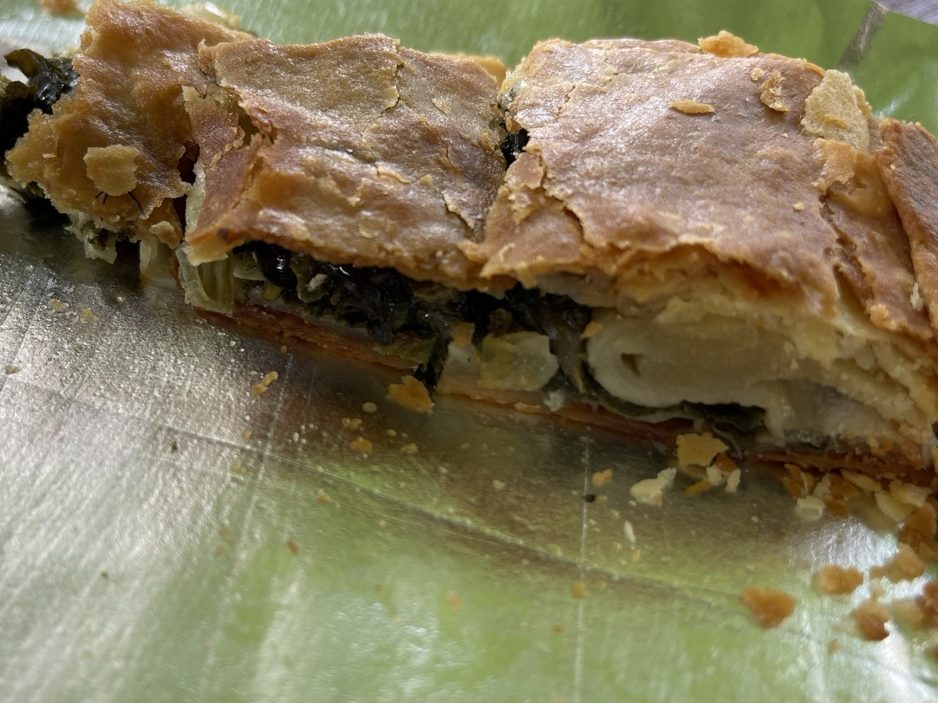
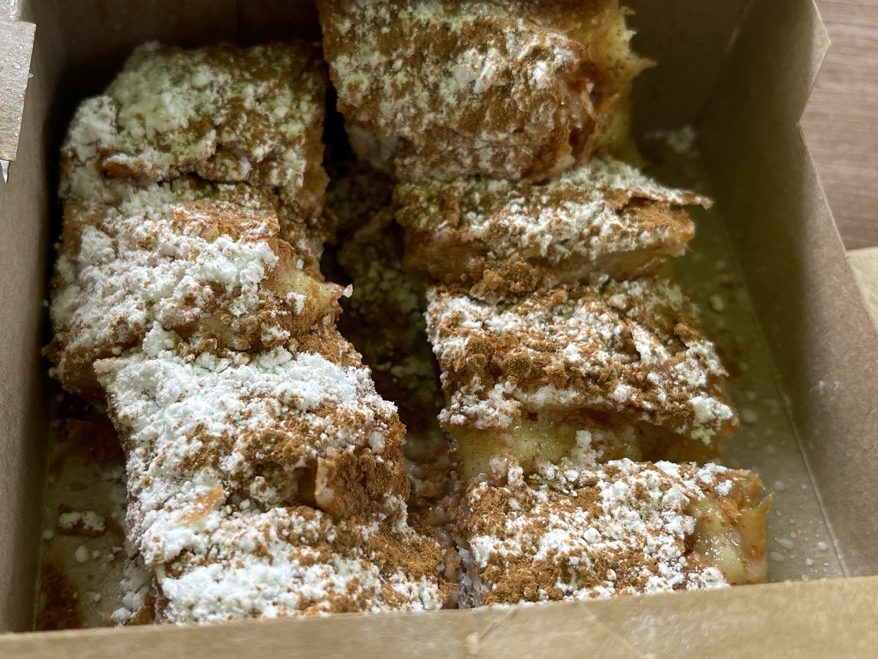
Varvakios Agora (The Central Market)
It’s important to pace yourself on these food tours, so we spent some time walking through the large central market to prepare for our next stop. Big fans of food markets, we make a point to visit at least one everywhere we travel. The most impressive thing about the Athens market is the huge variety of seafood. We have a wonderful variety of seafood in our Valencia Central Market, but I think Athens might have it beat.
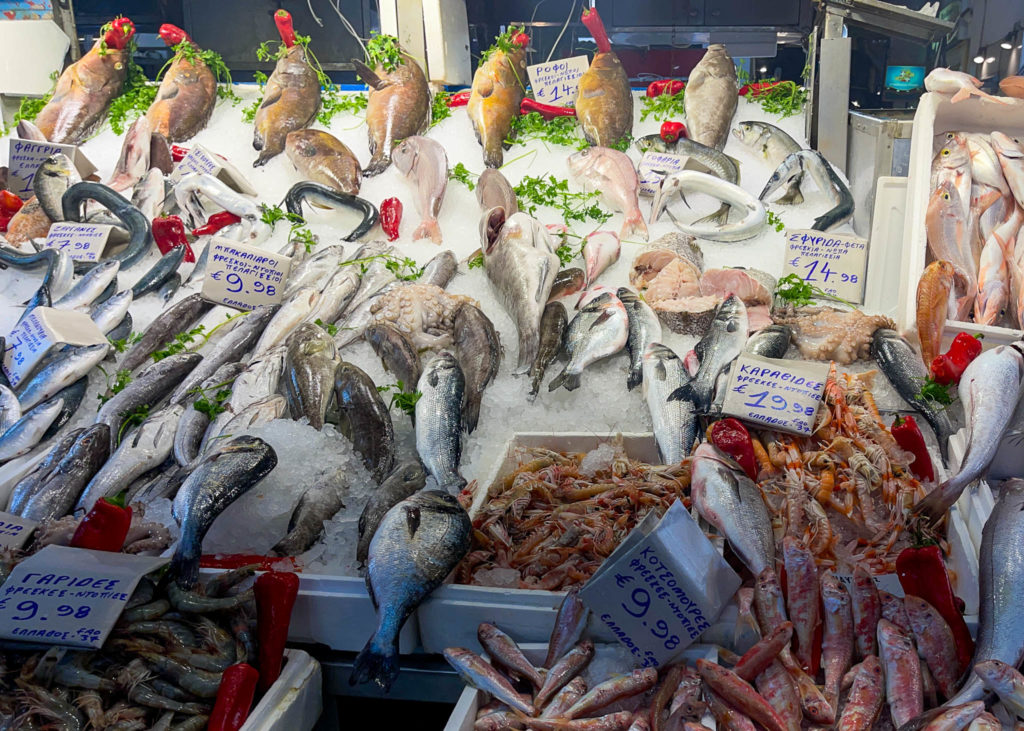
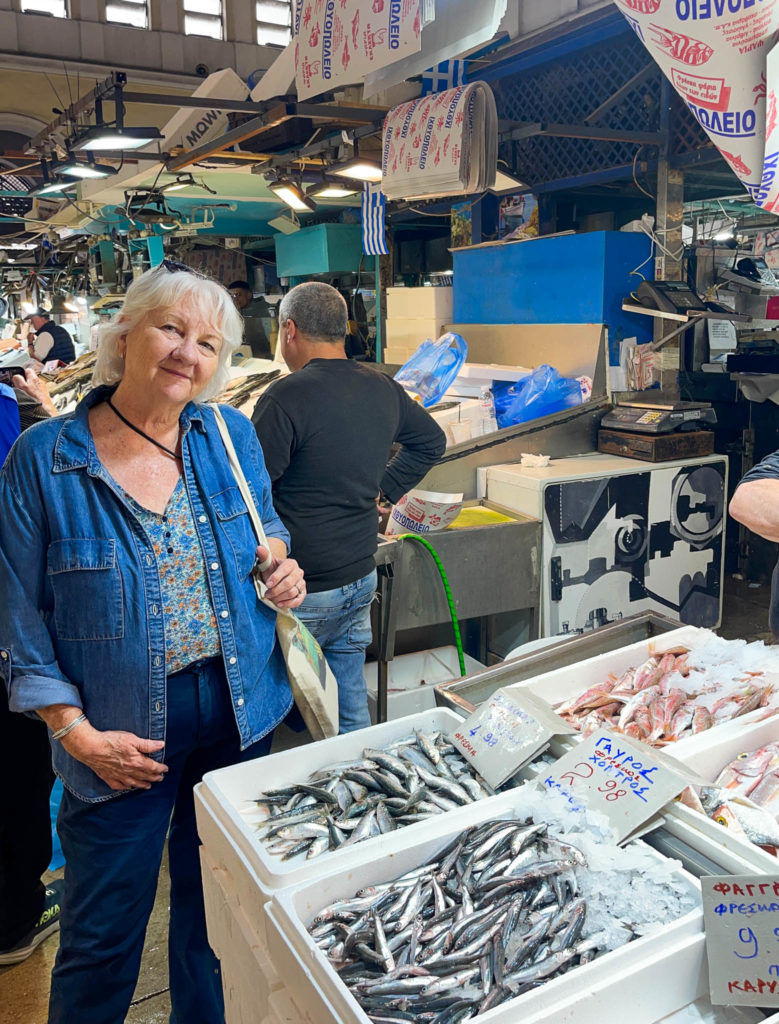
We stopped at a tiny shop in the market that has been serving mezethes there for several generations. Like tapas, mezethes are a plate of small bites. The Greek version includes saganaki which is cheese melted in a small frying pan until it is bubbling, topped with lemon juice and pepper, and eaten with bread. The cheese is typically halloumi, kasseri, or sheep’s milk feta. Our little meze plate also included grilled lamb patties, pork sausage, pepperoncini, tomatoes, and olives.
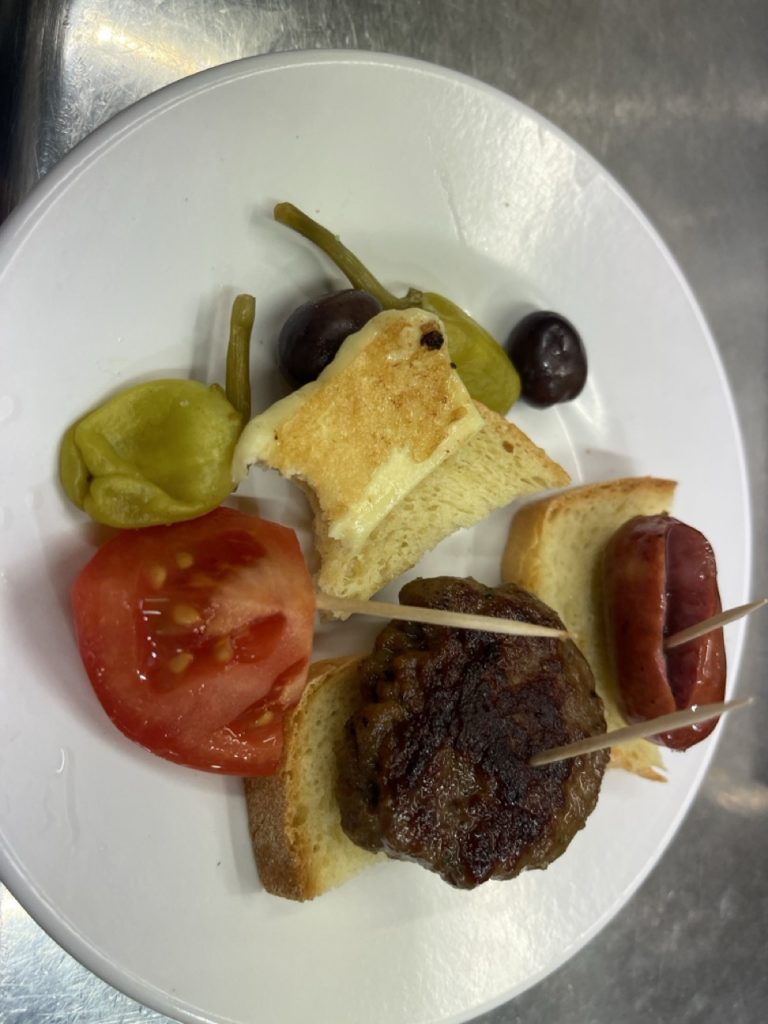
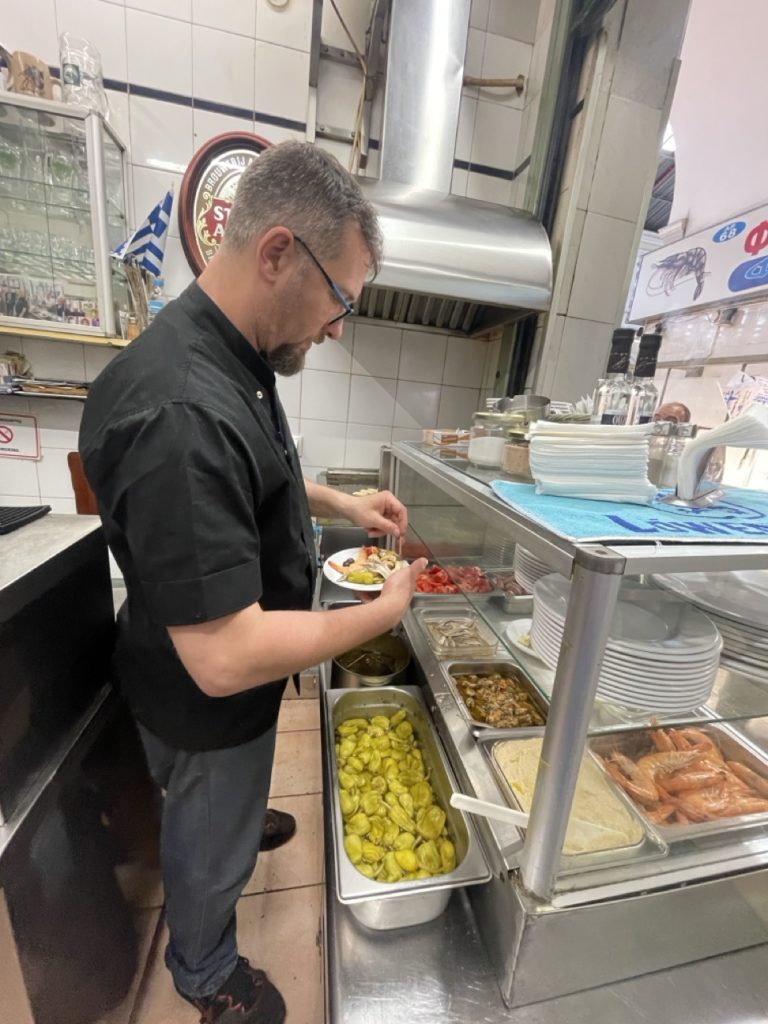
To accompany our mezethes, we sipped on tsipouro which comes from the northern regions of Greece. Tsipouro is a distilled spirit containing 40% alcohol made from the leftovers from the wine fermentation process. The first production of tsipouro was by Greek Orthodox monks in the 4th century. In modern times, it was made just for Greek households, and was illegal to sell. It was not until 1988 that the sale of tsipouro was allowed.
Donut Holes
After pausing to taste a variety of olives, we found ourselves in a small cafe that serves just one thing – Loukoumdades. Ktistakis has been serving up traditional Greek loukoumades since 1912. These pillowy fried dough balls have been served throughout Greece since the first Olympic games in 776 B.C. Ktistakis has perfected a method of double frying that results in a honey syrup center surrounded by a crispy shell. Always made fresh to order, dusted with cinnamon and sprinkled with chopped walnuts. Absolutely habit forming.
Got Milk?
Perhaps the most unusual place we visited, Stani is a 4th generation dairy bar that dates to 1931 and is the last of its kind. In bygone years, there was a popular tradition of stopping into a dairy bar for a glass of warm milk in the morning or to have creamy desserts such as rice pudding alongside evening coffee, but that practice has all but disappeared since widespread refrigeration means that families have their own milk at home. While dairy bars were known for serving warm milk, everything we ate was cold – and far more elaborate. First, there’s the yogurt. I’m not a huge fan of yogurt, but I couldn’t get enough of it while in Greece. This is strained yogurt made from the milk of sheep living on small farms near the city. An order takes the form of a thick dollop, drenched in honey, and generously topped with crushed walnuts. This yogurt is somehow light and rich at the same time, with a pleasantly milky aroma and a bright, subtly tart flavor. We also sampled galaktobouredo – a sweet, subtle custard wrapped in phyllo – and rice pudding. After a visit to Stani, it’s going to be hard to go back to what we call “Greek Yogurt”.
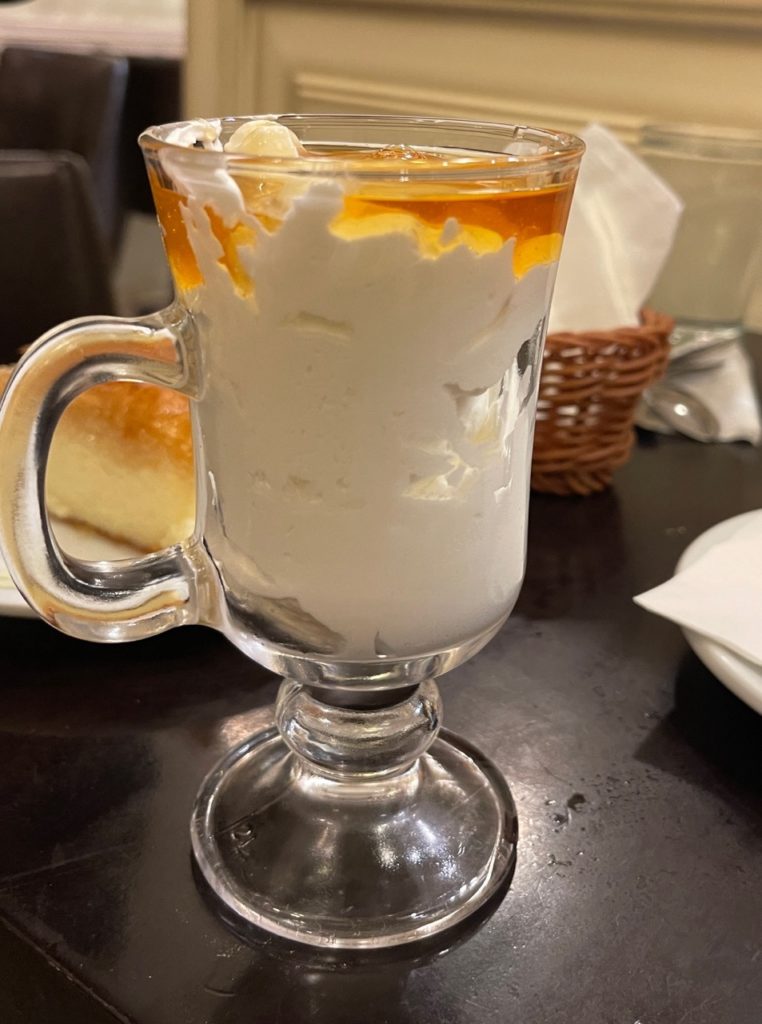
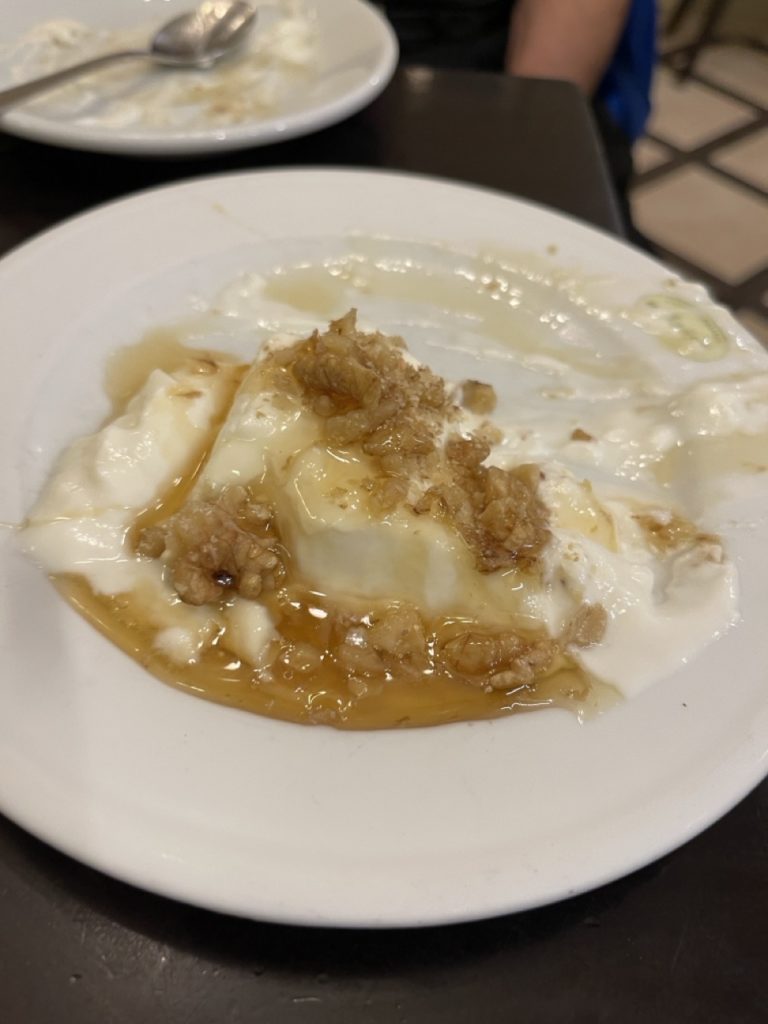
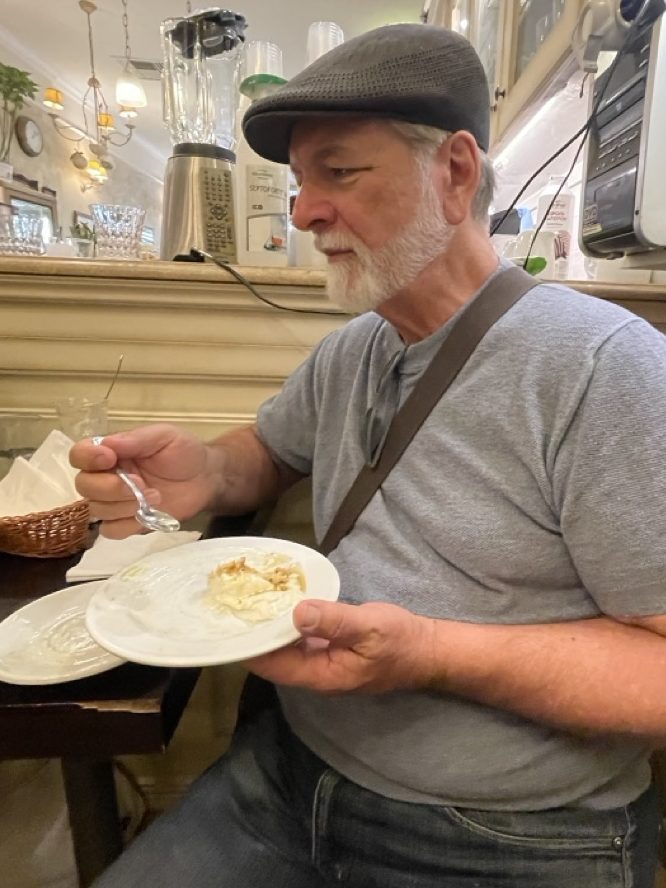
No Need to Change
Apparently, it’s virtually the law that you must have at least one souvlaki a day while in Greece. Meat on skewers, grilled, pita bread on top. Archaeologists have conclusively shown that the humble souvlaki, or an ancestral version of it at least, dates to the Greek Bronze Age.
“Agamemnon held the meats while lordly Achilles carved them into quarters, cut them well into pieces, pierced them with spits, and Patroclus raked the hearth, a man like a god making the fire blaze. Once it had burned down and the flames died away, he scattered the coals and, stretching the spitted meats across the embers, raised them onto supports and sprinkled clean pure salt.”
The Illiad, Book 9.
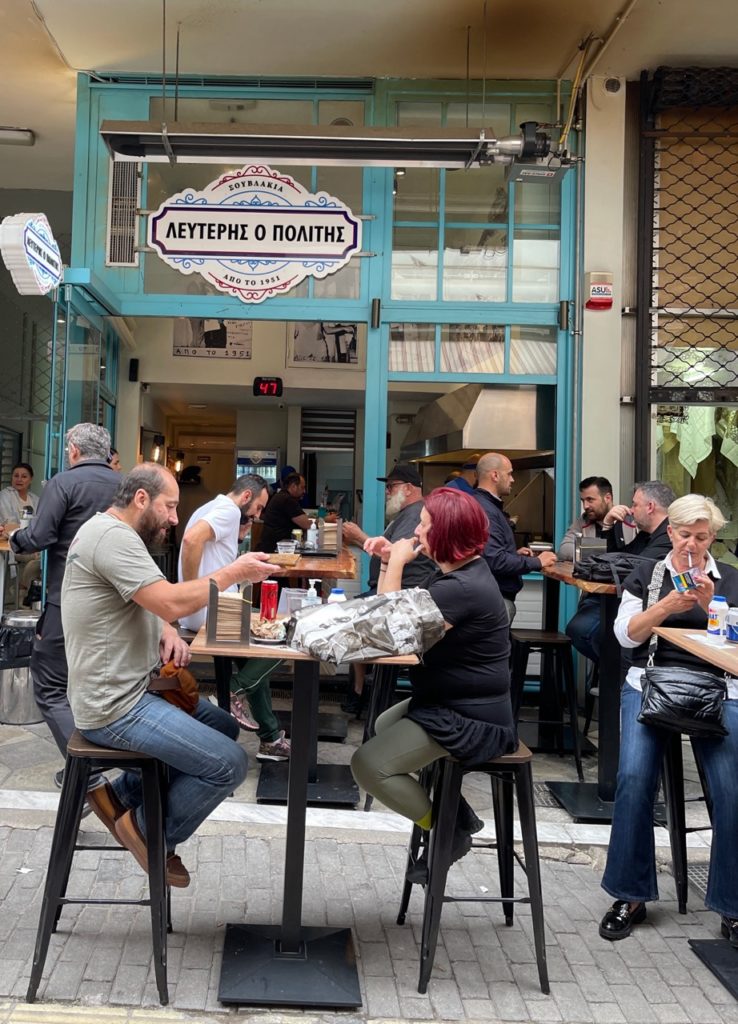
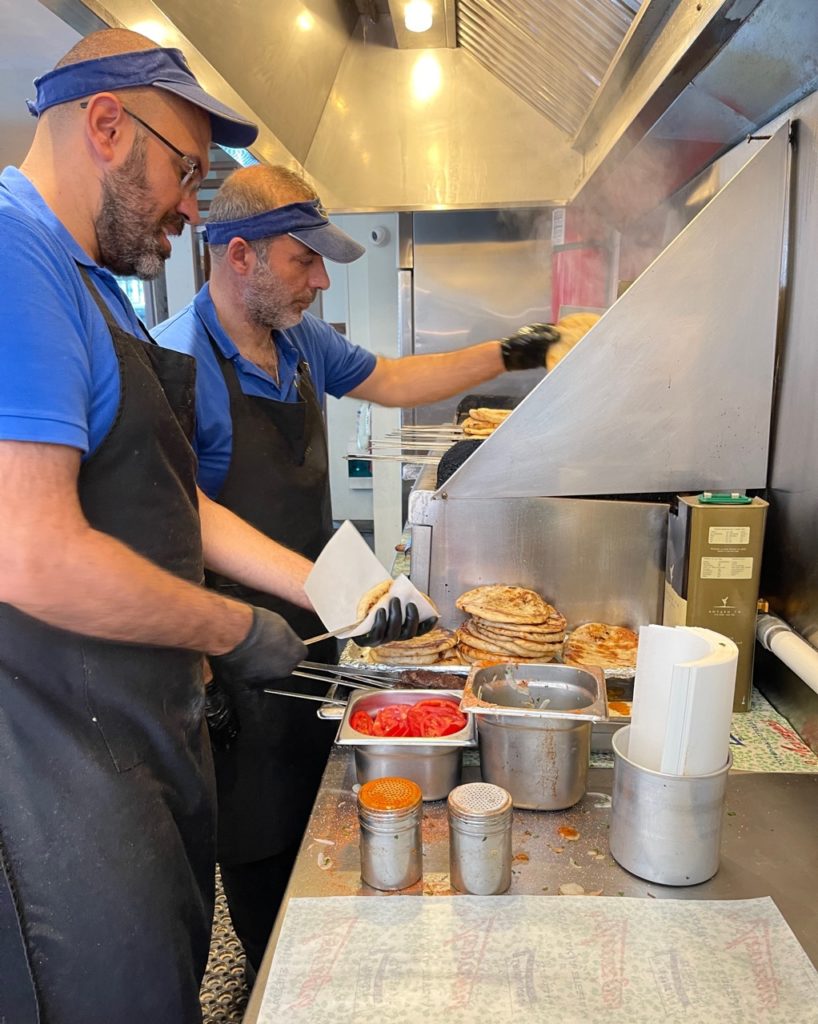
Souvlaki in Athens usually means a sandwich. In addition to the grilled meat, there’s a never-ending array of extras that can be added, but the most common ingredients are tomato, onion, parsley and tzatziki inside a warm pita bread. When I told the cook who prepared our souvlaki that it was delicious, he responded, “I know. I eat 3-4 every day.”
We finished the tour at about 3 PM with a traditional Greek feast for lunch. I can’t remember all the dishes on the table, but the grilled fish, marinated anchovies, sautéed greens, potato, and grilled sardines were highlights.
The Mediterranan Life
We skipped dinner (except for wine tasting), so we were prepared the next morning for a day of exploring Athens’ vibrant, bustling streets as we grappled with the juxtaposition of ancient ruins alongside contemporary buildings. The lovely Plaka neighborhood charmed us with its narrow streets and neoclassical architecture. We felt at home with the warm climate and Mediterranean lifestyle evident in the numerous open-air cafes, lively markets, and friendly people.
We also had the delight of meeting Elli, Nayan and Jo’s dear friend whom we’ve heard so much about for many years. Now retired, Elli spent more than 40 years as a tour guide. She treated us to a personal tour of the city and then drove us out to the Temple of Poseidon.
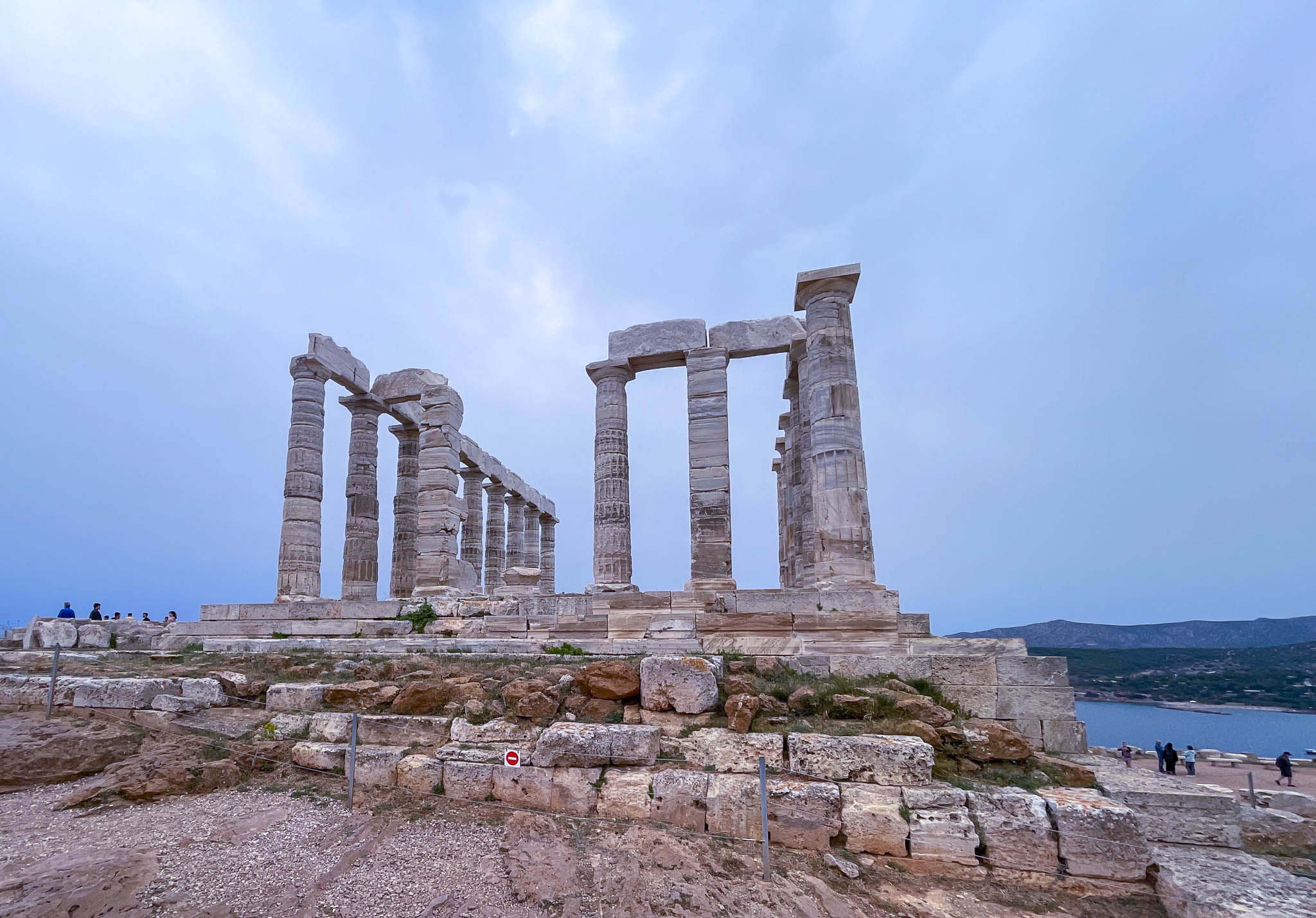
High City
On day three, our good friends and traveling companions, Debby and John, arrived and we headed to the Acropolis. Crowned by the Parthenon, the Acropolis dominates the skyline, offering a powerful reminder of the city’s ancient glory. Walking around the base of the acropolis, we encountered numerous other archaeological sites, such as the Agora, the Temple of Zeus, Hadrian’s Gate, the Herodica Atticus Theatre, and the Theatre of Dionysus.
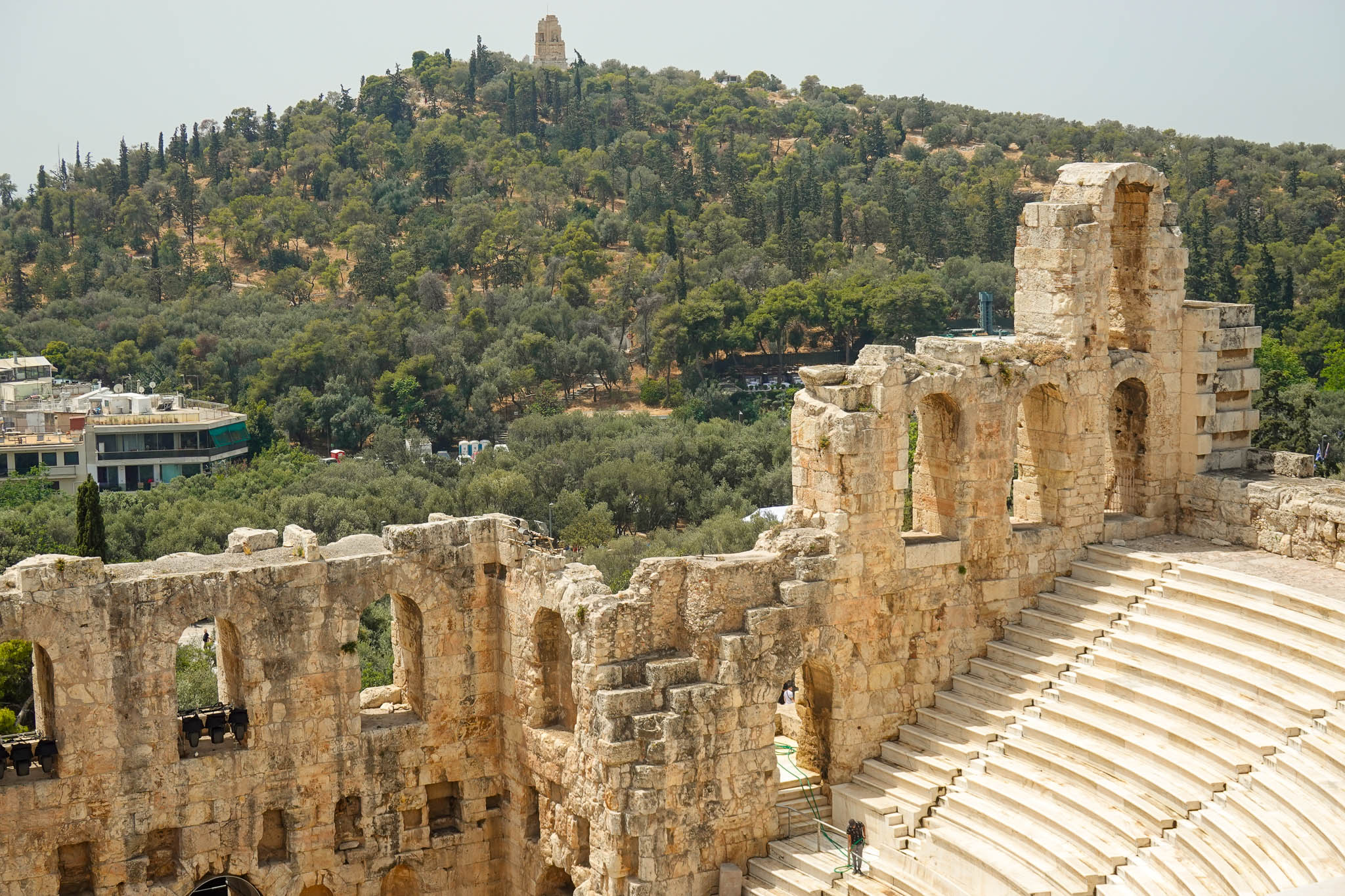
The walk up to the top of the Acropolis is more than worth the effort. The sheer scale and beauty of the Parthenon evokes a deep sense of awe and connection to the past. Other than the Parthenon, my favorite Acropolis ruin is the Erechtheion with its famous Caryatids (the Porch of the Maidens). The Acropolis of Athens is more than an ancient ruin; it is a powerful symbol of human achievement, creativity, and resilience. It leaves a lasting impression.
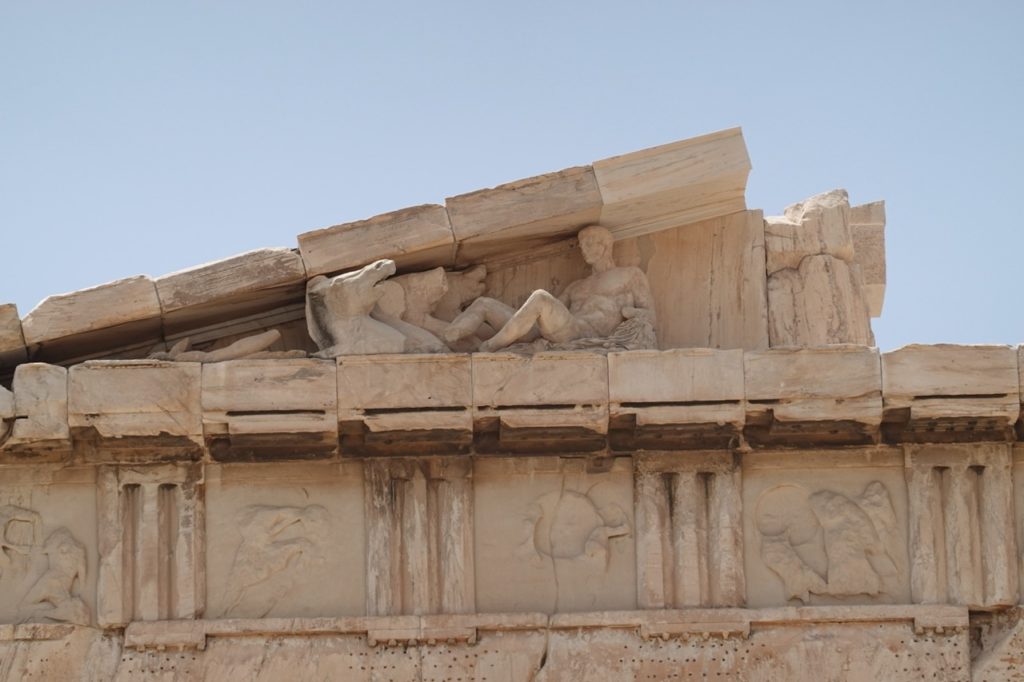
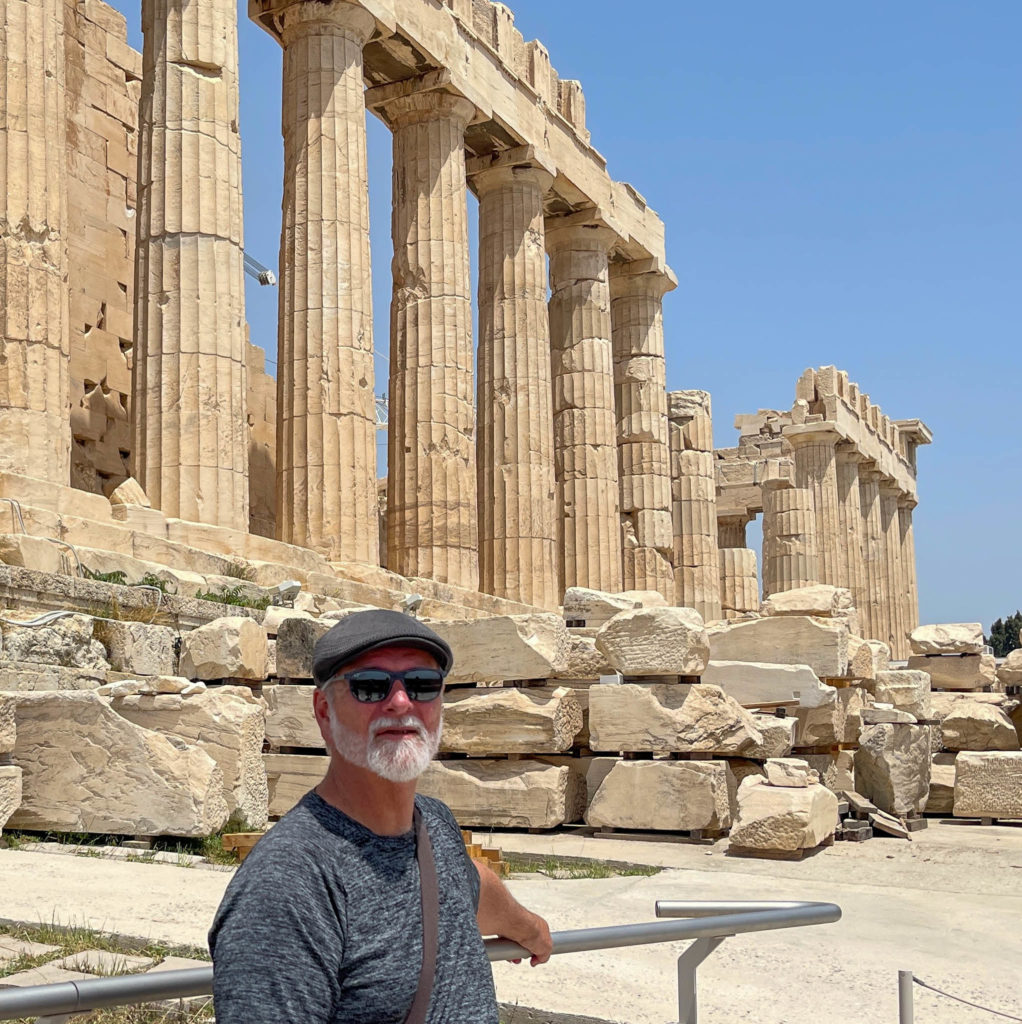
The nearby Acropolis Museum displays artifacts and sculptures found on the site, providing context and depth to the understanding of ancient Athenian life. The contemporary design of the museum blends perfectly with its historical surroundings. The sleek glass and concrete structure provide stunning views of the Acropolis and creates a visual connection between the artifacts and their original context. Glass floors allow one to see the archaeological excavations of an ancient Athenian neighborhood.
Center of the World
After four days in Athens, we hit the road and our first stop was the Athens airport to pick up Debby and John’s good friend, Kim. The big city behind us, we headed north. Our first stop was Delphi, located on the slopes of Mount Parnassus in central Greece. According to Greek mythology, Delphi was the center of the world. Zeus is said to have released two eagles from opposite ends of the earth, and they met at Delphi, marking it as the omphalos, or navel of the world. People from all over the Greek world and beyond would come to consult the Pythia, the high priestess of the Temple of Apollo, for guidance on various matters, from politics to personal decisions.
Delphi is renowned for its impressive ancient architecture. There’s a well-preserved theatre, a stadium used for the Pythian Games, a precursor to the Olympic Games, and an Archaeological Museum containing a collection of artifacts found at the site. Once again, we found ourselves in a place where history, mythology, and natural beauty converge, offering a deeply enriching experience.
Suspended in Air
After driving another couple of hours north, we stopped in the town of Kalambaka which is at the edge of a truly striking and surreal landscape. Meteora, which means “suspended in air,” is a landscape of towering rock formations with ancient monasteries perched atop them. Originally, there were 24 monasteries built between the 14th and 16th centuries by monks seeking solitude and spiritual retreat. Today, six of these monasteries are still active and we were able to visit two of them – St. Nicholas and St. Stephen.
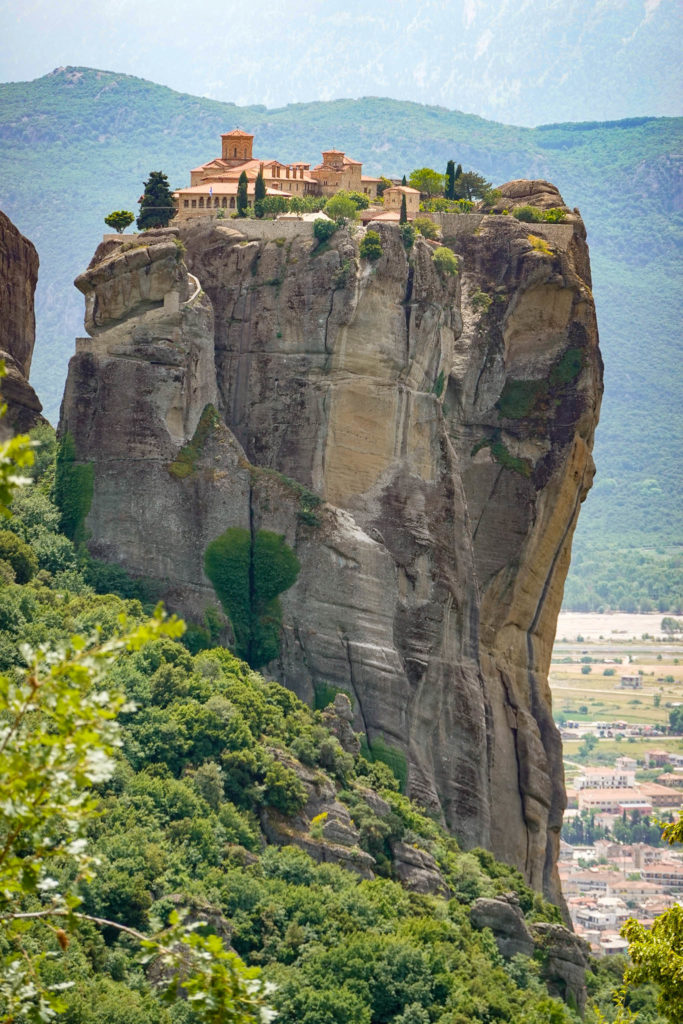
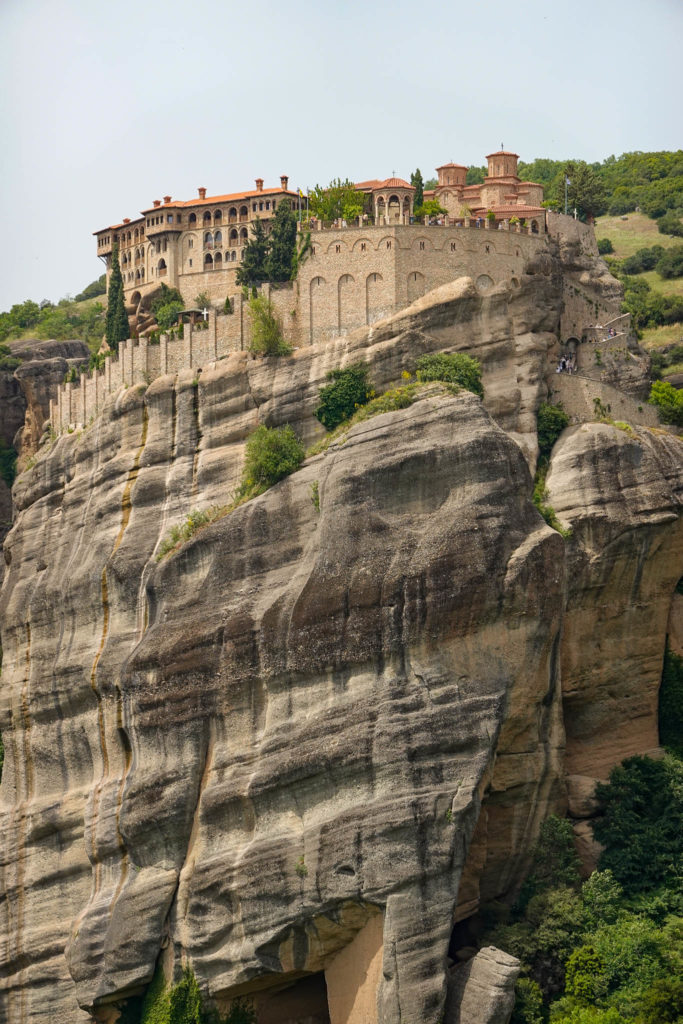
The Monastery of St. Stephen at Meteora
Back on the Road
After two days in Kalambaka, we drove to the Peloponnese region of Greece in the southern part of the mainland and connected to the rest of Greece by the Isthmus of Corinth. Steeped in history, with significant archaeological sites dating back to Ancient Greece, the Peloponnese landscape is diverse ranging from rugged mountains to fertile plains and pristine beaches.
Rocks and Ruins
We spent a full day exploring three remarkable archeological sites of the Peloponnese. Our first stop was Mycenae, a major site of pre-historic Greek civilization known for the tomb of Agamemnon and the Lion Gate, both built of massive stones that legend claimed were placed by the cyclops. Next, we strolled through the ruins of ancient Corinth, once a prominent and wealthy city. Epidaurus, a healing center with an ancient theater renowned for its exceptional acoustics, was our final stop.
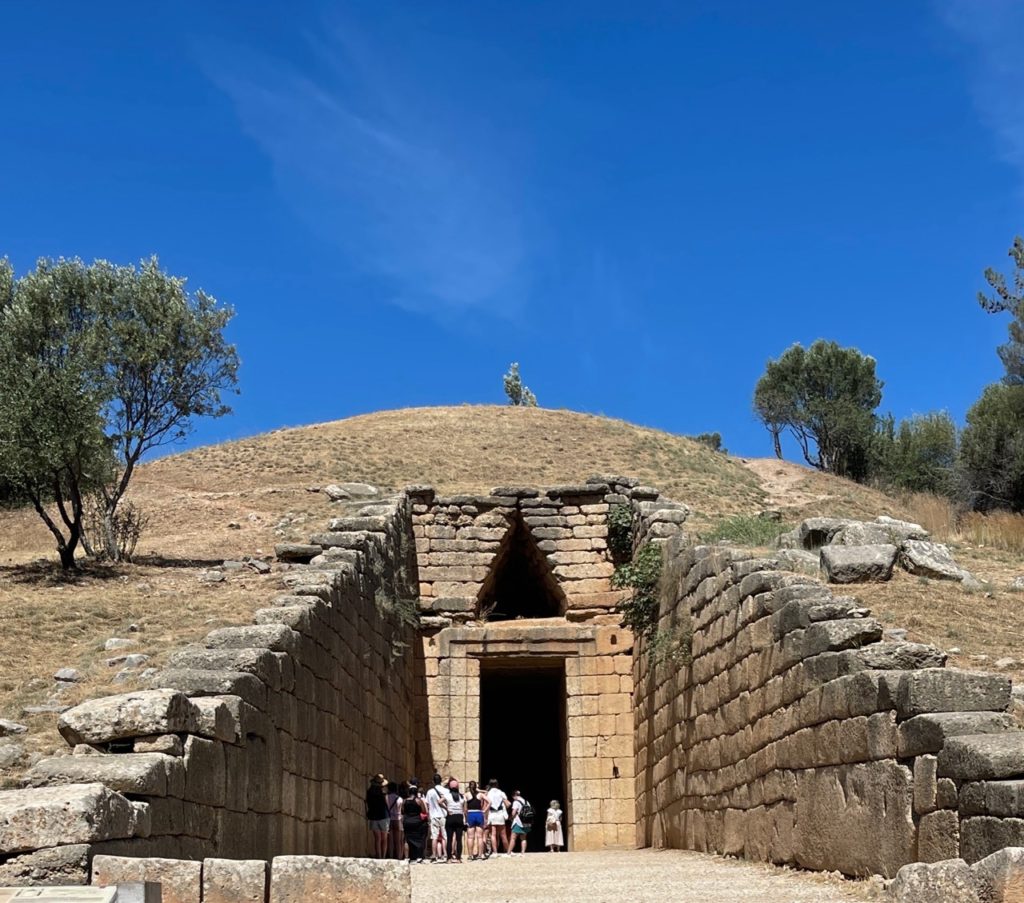
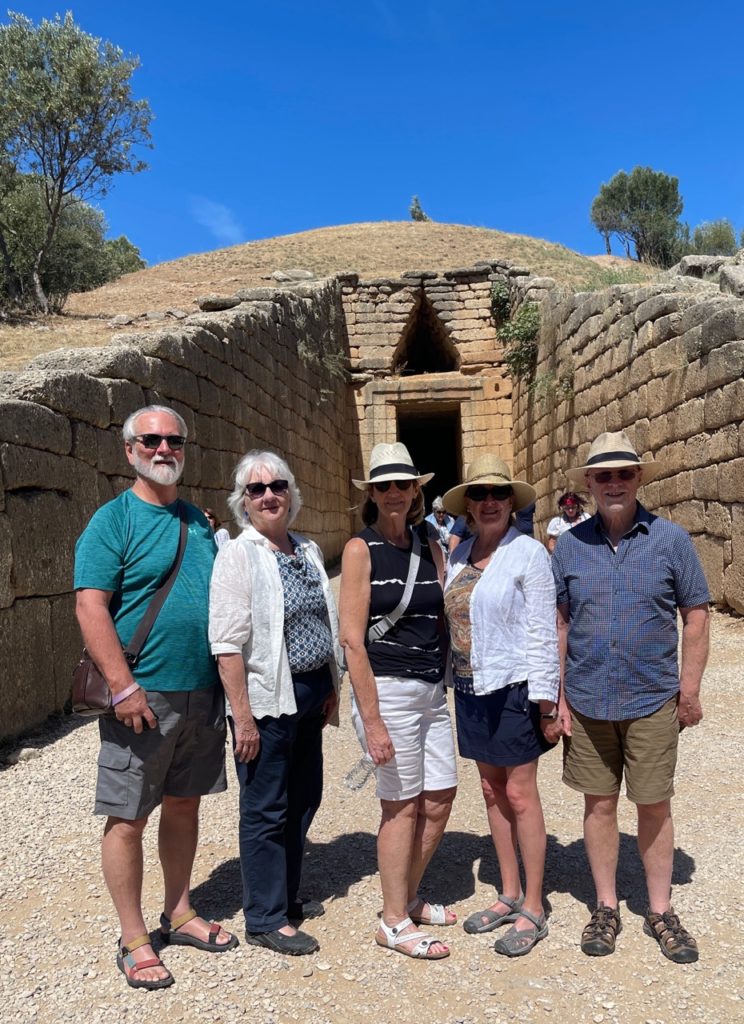
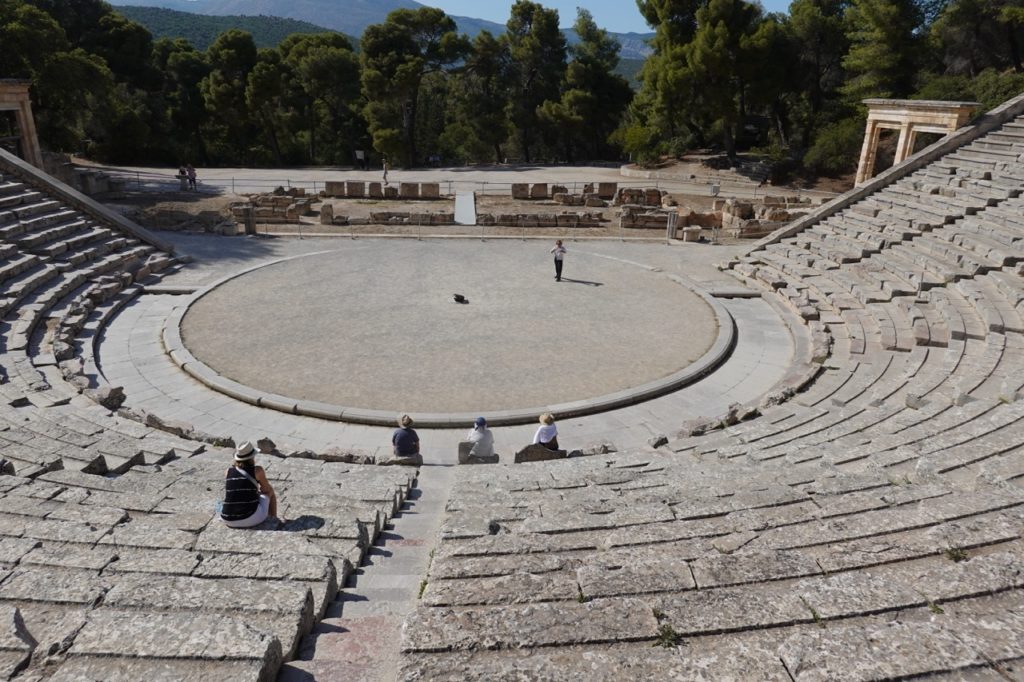
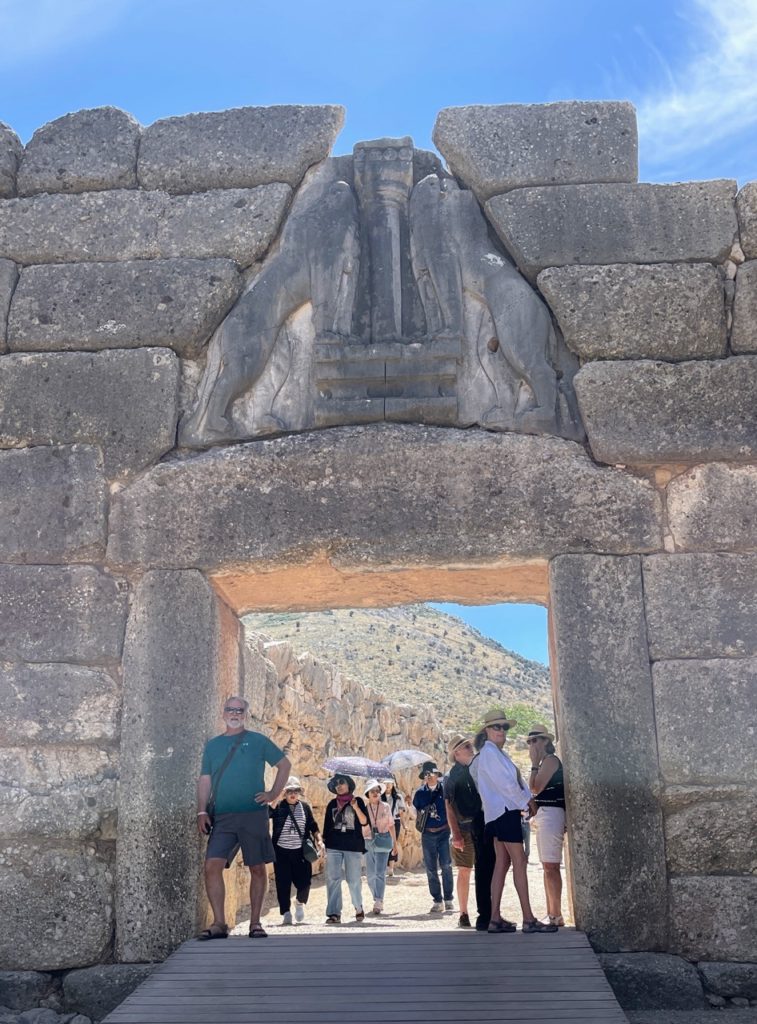
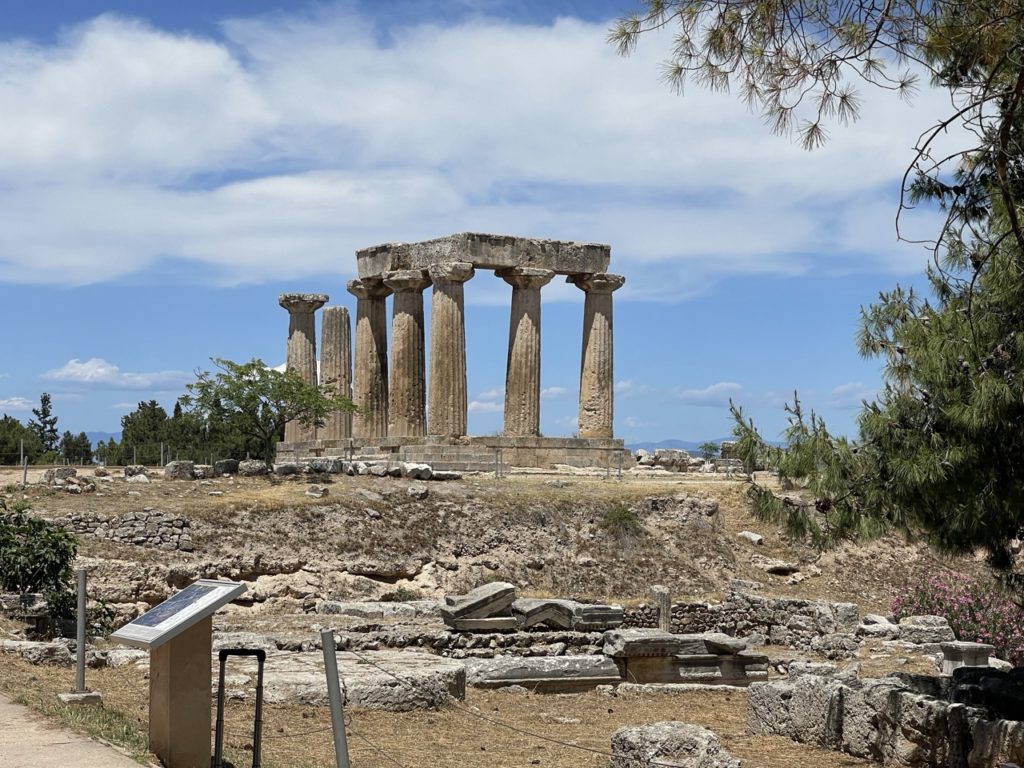
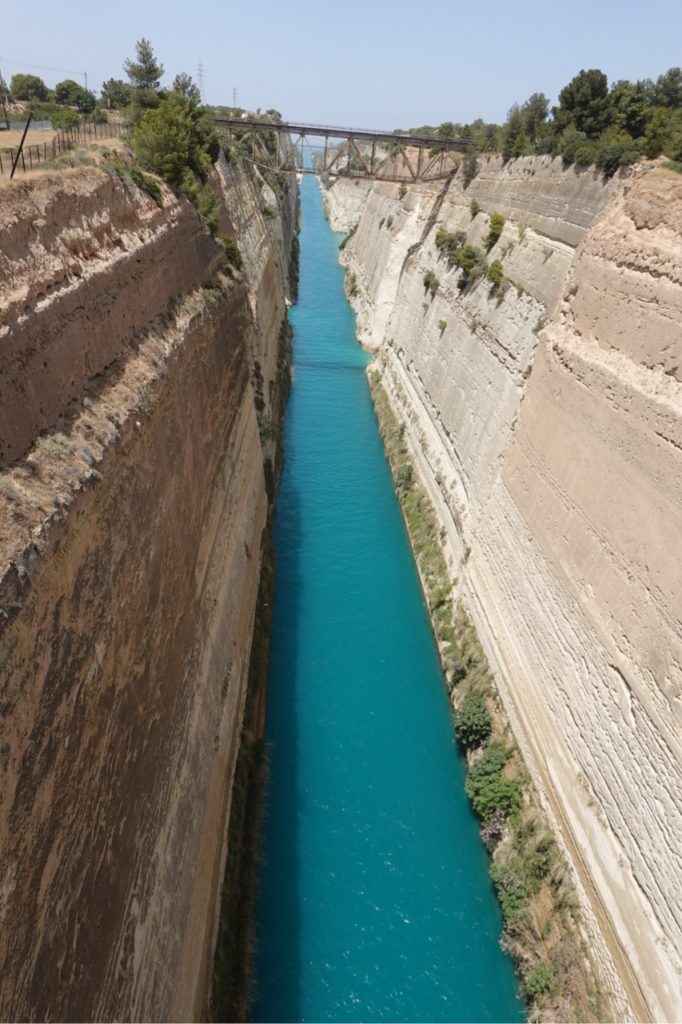
A Day at Sea
We stayed in the seaside town of Nafplio enjoying its beautiful harbor and charming old town with Venetian and Ottoman architecture, narrow cobblestone streets, numerous cafes, and small artisan shops. Needing a break from ancient ruins, we spent a lovely day on a sailboat cruising and swimming in the crystal clear, aquamarine waters around Nafplion.
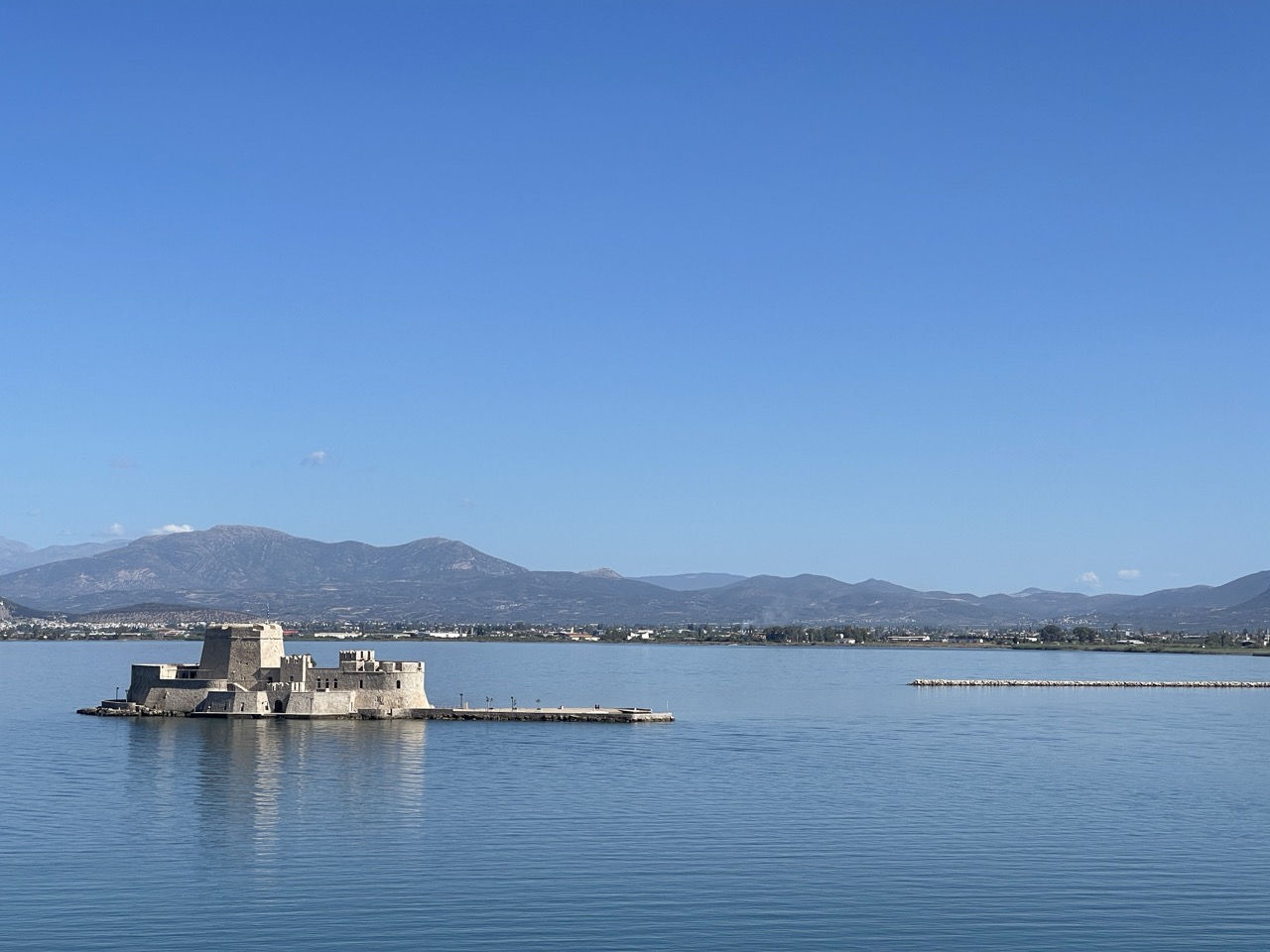
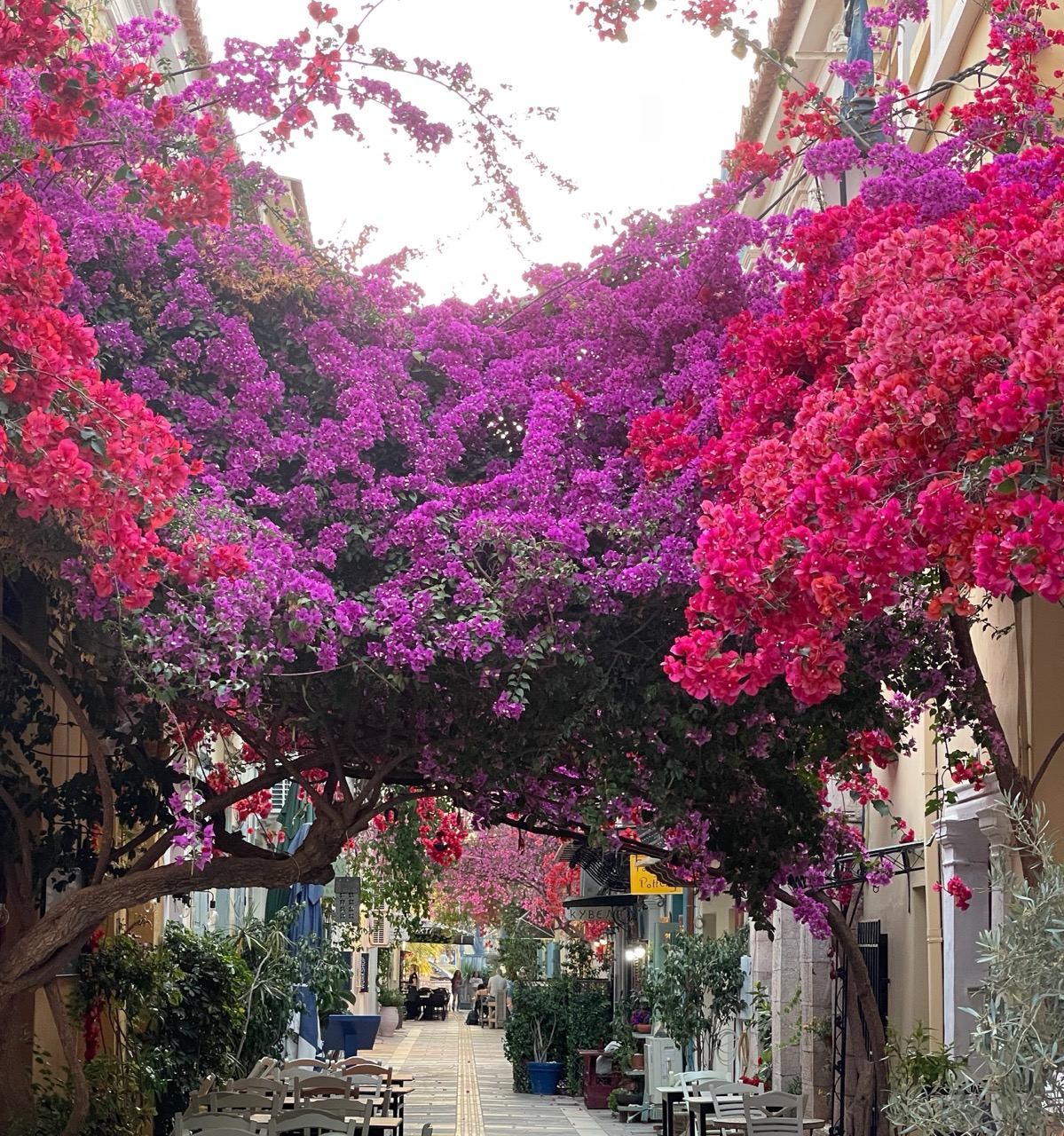
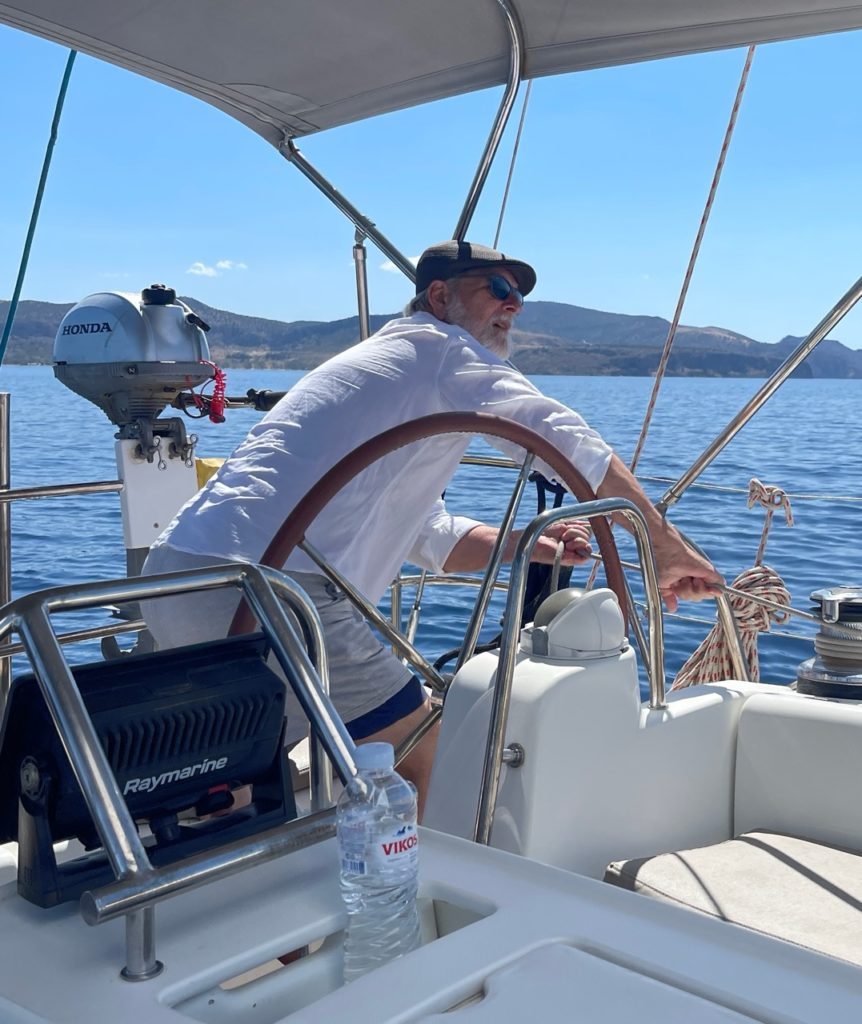
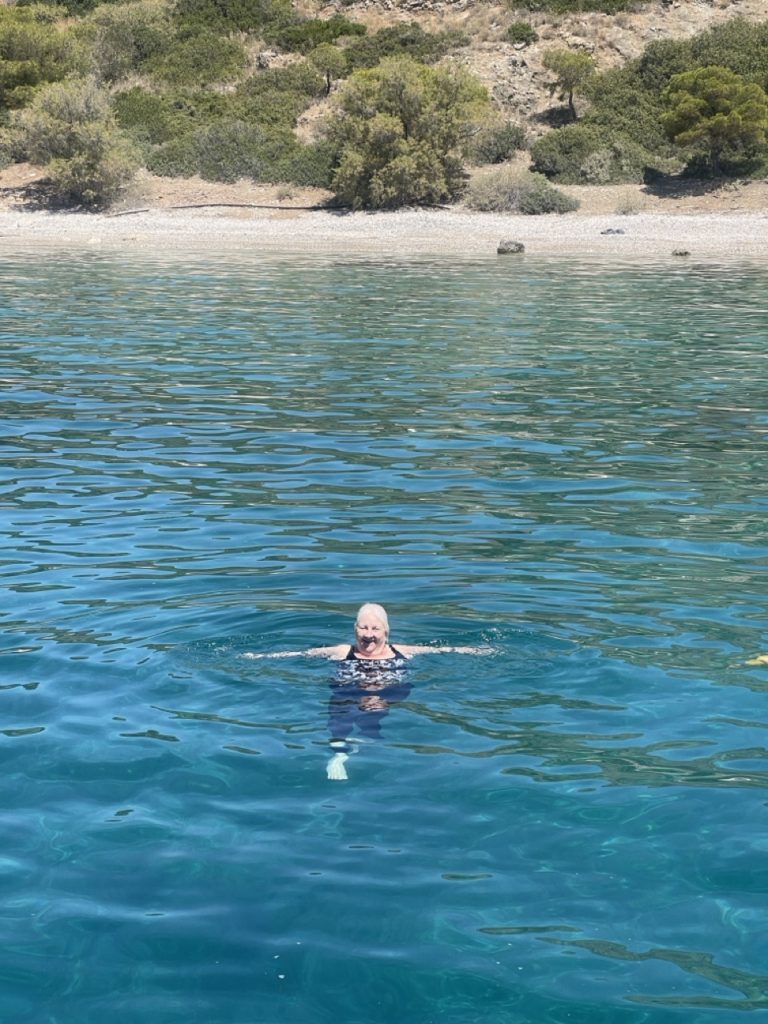
A New Superfood
Chios, a beautiful Greek island on the eastern edge of the Aegean Sea, is where the mastic tree (shrub related to the pistachio) grows (and nowhere else in the world). Mastiha, the resin from these trees’ drips in thick, liquid tears onto the ground, which then crystalize after a period of about 15-20 days. These resin “tears” are harvested, cleaned, and stored to be used for flavoring ice cream, breads, pastry, candy, and liqueurs.
The first references to mastiha on Chios can be found in the work of Herodotus, the ancient Greek historian, who, in the 5th century BC, described how the ancient Greeks collected the resin and chewed it, both for pleasure and hygienic purposes. The first chewing gum! Ancient Greek healers like Hippocrates praised mastiha, for its medicinal and pharmaceutical uses and prescribed it widely. A natural antioxidant with strong anti-inflammatory and antimicrobial properties, mastiha is a superfood. So, why am I telling you all of this? Well, mastiha is also the key ingredient in the wonderful after dinner liqueur we enjoyed after every meal in Nafplion! (Thank goodness for the duty-free store at the Athens airport.)
So Many Islands, So Little Time
After ten wonderful days, we were forced to say goodbye to our fellow travelers and make our way back to Valencia.
Visiting Greece is a profound experience. You are confronted with the voices of the past if you are open to listening. The Greeks were searching for more than luxury and comfort. They pushed the boundaries of philosophy, spirituality, and beauty, searching for perfection in a civil society in ways we are still trying to understand. We’re looking forward to returning to Greece in September to celebrate our anniversary – this time our focus will be on the islands!
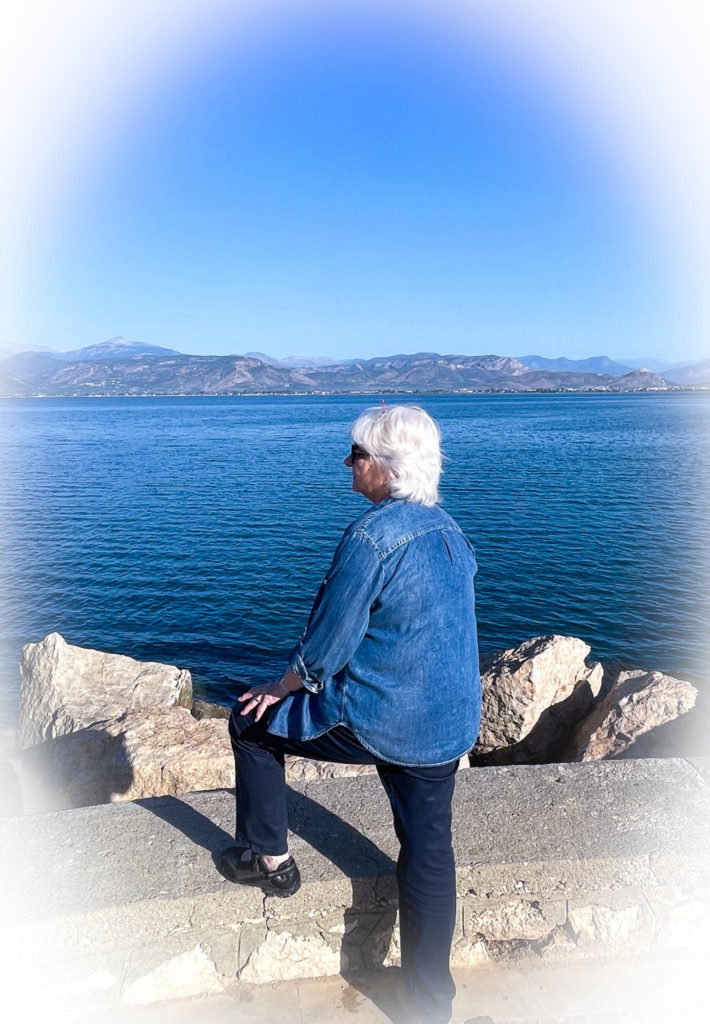
About Us
Welcome to our little corner of the world where we invite you to embark on exciting journeys with us!
We’re Ed and Bonnie, a duo passionate about exploring the world and experiencing its wonders. Our love for travel isn’t just about discovering new places; it’s about sharing those moments with cherished family and friends like you.
Our hope is that you will feel like you’re right there with us, sharing in the excitement and wonder of each destination. Better yet, let’s plan a rendezvous somewhere wonderful! Learn more

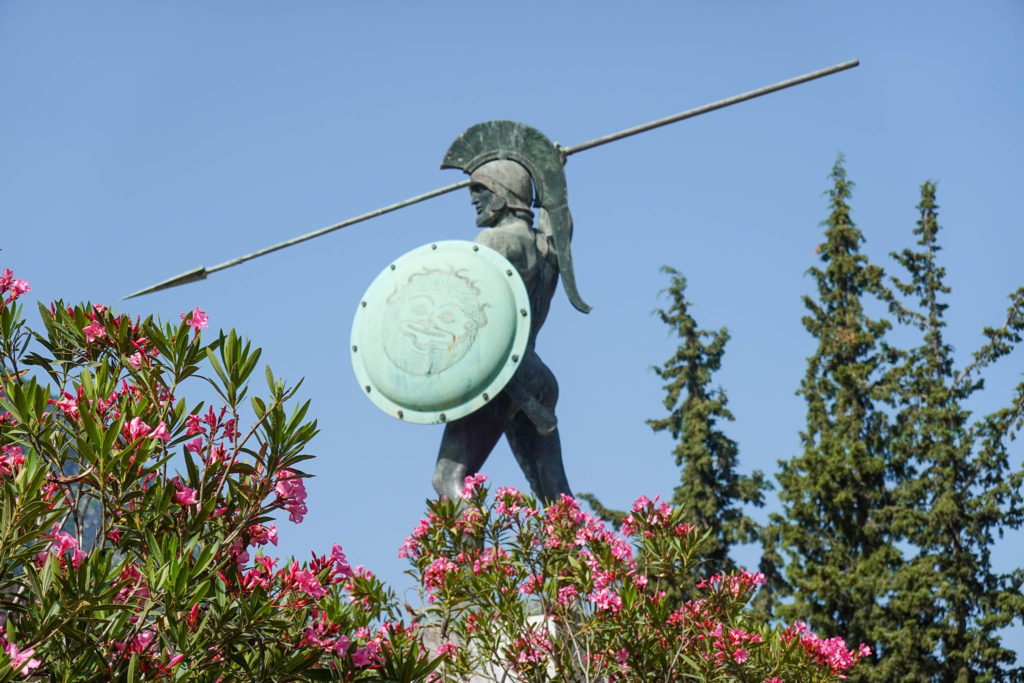
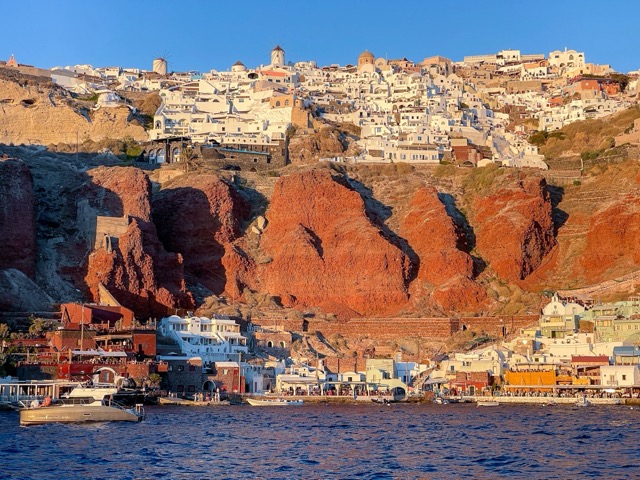
Looks incredible!
Gorgeous photos. The bougainvillea pix alone makes me want to travel there. You don’t mention the weather so I’m hoping you missed the heat wave in Greece we are reading about now. Glad you experienced this and glad you took the time to share it with us!
That is so awesome, I’ve been wanting to go to Greece. Some day. glad to see you are having such a great trip/adventure.
Greece is on our wishlist for next year – what a wonderful trip you had! What’s the name of the mastiha liqueur? And when will you be back in Valencia?